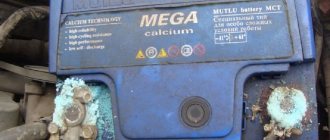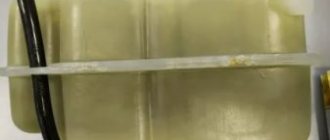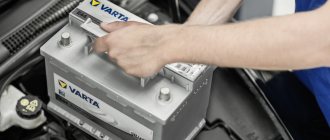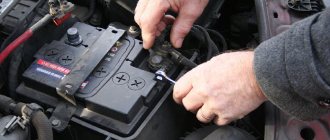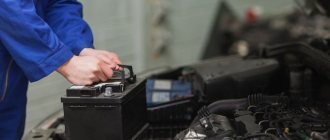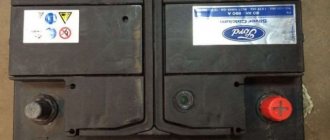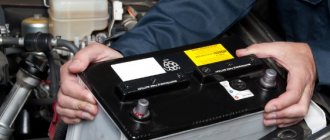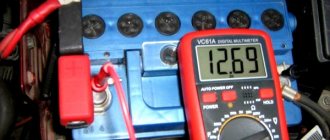A modern car is a convenient and reliable form of transport that does not require daily maintenance and preparation. Sometimes the hood does not open for months. But one day, looking under it, you can find significant deposits of white, blue or green plaque on the battery contacts. Naturally, you wonder how to clean the battery terminals and protect them.
Causes of corrosion and oxidation of terminals
In common parlance, a battery terminal refers to both the battery terminals and the metal strip with a wire attached to the terminal. To distinguish them, they are called “battery terminal” and “wire with terminal”. But for an accurate understanding of which of the two terminals is being talked about at the moment, it is customary to distinguish between them.
The battery has two terminals: positive “+”, negative “-“. Wires are attached to them using metal clamps to transmit current from the battery to the vehicle's on-board network. These devices are usually called battery terminals, positive and negative.
Rechargeable batteries accumulate and release electrical energy as a result of a chemical reaction. This reaction is accompanied by the oxidation of lead during discharge and the decomposition of lead sulfate salts during charging. But for decomposition, lead sulfate must be in the electrolyte.
The white coating is mostly lead sulfate. And since the battery terminals are not in the electrolyte, lead salts only accumulate and do not dissolve during battery operation.
But why does battery contacts oxidize? Batteries are sealed containers, but during use on vehicles, microcracks appear between the battery terminal and the material of the battery cover. Electrolyte vapors penetrate through these cracks and oxidize the contacts. The more vapor, the more salt deposits. We will tell you how to avoid the appearance of microcracks and oxidation at the end of the article.
Another common cause of corrosion is the incorrect choice of metal for the terminals, or the absence or wear of the protective coating on them. This happens if the original factory clamps were replaced with a cheap analogue. Lead should not be combined with steel, magnesium, silver-plated or gold-plated surfaces. Under the influence of electric current, accelerated corrosion of metals occurs at the point of contact. Even copper at high air humidity can not get along well with lead. Then a coating of blue-green powder appears on their surface. The best metals to ensure a reliable connection are: lead itself, tin, zinc, titanium. However, even the best combination of a pair of metals is susceptible to the effects of sulfuric acid vapor.
Why do battery terminals oxidize?
The appearance of a white coating on the battery electrode contacts indicates that favorable conditions have been created for corrosion processes. This may happen due to the following reasons:
- Poor terminal tightening. Many drivers, especially if they often have to disconnect the wires from the battery, throw them over the terminal terminals without tightening them. It is strongly not recommended to do this, even if it seems that the terminal is “in place” tightly and securely. Over time, the contact is still weakened, gaps appear, into which sulfuric acid vapors released during the electrolysis process fall. Corrosion in copper clamps is also facilitated by the fact that they are under voltage, promoting sulfation of the metal. So the terminal connection always needs to be tightened. But you can’t use excessive force either - both the battery electrodes and the terminals themselves are made of soft metal, which can be deformed or even burst.
- Leakage of electrolyte from the battery. This process occurs especially often in serviced batteries that have filler plugs for electrolyte, which are also drainage holes for releasing gases when the liquid boils. A hydrogen gas leak most often occurs when the battery is overcharged or the electrolyte is overfilled beyond the permissible limit.
Maintenance-free batteries are largely devoid of this drawback - the processes of electrolyte entering the terminals here occur only on aged cases with microcracks.
Sometimes the electrode itself becomes leaky. But whatever the reason for the oxidation of the battery terminals, you first need to clean them, and only then begin troubleshooting, if possible.
How to determine when it's time to clean
The presence of salt deposits is determined visually - these are small white crystals. Irregularities on the surface of the contact pair allow electrolyte vapor to get inside, then the contact surface can oxidize inside. Lead sulfate salt is a dielectric, meaning it has high electrical resistance. Salt causes a loss of tension at the junction. Therefore, at the point of contact, at high inrush currents, a large amount of heat can be released. Over time, this leads to burnout of some of the metals on the contact surface, which further increases resistance and heat generation. Subsequently, when starting the engine, sparking appears at the battery terminals and terminals, which means that metal burnout intensifies. The consequence will be the appearance of shells, which will reduce the useful contact surface.
If white deposits appear, even in small quantities, it is worth cleaning the oxidized contact elements. Well, if when starting the car engine they warm up, the more noticeable the sparking is in the dark, then urgent measures need to be taken.
There are also indirect signs indicating the need to check the condition of the battery terminals. This is a difficult engine start. Higher voltage drop at start-up. Dimmer side lights when the engine is not running. The reasons may be various, but including poor connection between the clamps and terminals of the battery.
How to clean battery terminals from oxidation. The most common causes of oxidation.
A white coating may form on the battery terminals. This is oxidation, which can lead to poor contact in the terminals. In this case, the current that the starter receives decreases when starting the engine, and the crankshaft speed drops. In winter, this manifests itself to a greater extent, for the reason that during this period the oil in the engine crankcase becomes thicker, and the load on the starter increases. In severe frost in the morning, the engine may not start even with a fully functional and charged battery. But even if it starts, the contact in the oxidized terminals may periodically disappear, as a result of which the battery will not receive enough charge.
Most often, terminals oxidize for the following reasons.
1.
Microcracks may form in the battery case. This occurs around the battery output terminals. Electrolyte vapor passes through them and condenses on the terminals. Over time, they become covered with a white coating. If the terminal is poorly tightened or there is a gap between them, then vapors will enter it, and oxidation will occur not only on the surface of the terminals, but also at the points of contact.
What tools and materials will be needed
To disconnect the wires from the battery, you will need a 10 mm wrench. A screwdriver with a flat blade 4–7 mm wide to widen the gap in the terminal and separate it from the terminal surface. If the battery is removed from the car, you will need a key to remove the bracket or clamp holding the battery.
There are entire sets of tools on sale for cleaning connecting parts. They can easily clean any contacts. But we will consider methods using improvised means.
To remove salt oxidation from contacts, you may need:
- a brush with hard bristles made of fishing line or metal wire or felt for initial cleaning;
- a brush with metal bristles for cleaning the inner surface of the terminal;
- an old toothbrush for applying an alkaline solution - an acid salt neutralizer;
- baking soda or a piece of laundry soap, or a specialized spray to neutralize acid salt;
- sandpaper with abrasive No. 80–150;
- water for rinsing from the neutralizing solution;
- rags for washing and wiping;
- rubberized gloves to protect hands.
You can get by with a minimal set or just a rag, but the presence of these tools and materials will allow you to thoroughly clean the connecting elements and ensure reliable contact.
Cleaning the Battery Terminals
In the simplest cases, felt is used, which copes well with small oxidation centers of size and thickness. By the way, it resists acid well, which cannot be said about other common materials, including various sponges.
Sometimes they use an aqueous solution of soda and a toothbrush, but all these methods are only suitable for light stains.
When oxidation affects large areas of the contact group, it is necessary to use sandpaper, but always a fine-grained fraction - it is important that no abrasive particles remain on the surfaces of the metal being processed.
A rougher tool for cleaning battery terminals is metal brushes with wire bristles - they clean quickly, but will require final sanding with sandpaper. There are also special double-sided devices on sale - brushes, one of the sides of which cleans the battery electrodes, and the other - the inner surface of the terminals.
Advanced motorists use a screwdriver with a special brush as an attachment; to get rid of oxide, the rotation mode is used at medium speed. In any case, cleaning the battery terminals must be done carefully and conscientiously. If you leave even a small untreated area, the process of re-oxidation is inevitable.
After cleaning the battery terminals, you need to carefully inspect the surface of the battery for cracks and other defects - it is likely that they are the cause of the rapid appearance of a white coating. Such a battery cannot be restored, so it is better to immediately think about buying a new car battery.
If there is no visible damage, after cleaning the battery terminals with an aqueous solution of baking soda, it should also be used to clean the battery case from contaminants - dirt, dust, sulfuric acid residues.
Some motorists use a special battery terminal cleaner instead of soda. This option is also not bad, but, as a rule, such products are made on a solvent basis, so there is little point in spending money on purchasing it.
Another common means for cleaning the electrode and terminals from white deposits is gasoline, which actually has the ability to dissolve many contaminants, including oxides of various natures. But when using gasoline, you need to work very carefully - in addition to dirt and white residue, it also has a destructive effect on other materials - rubber and plastic. The battery case is made of plastic. The safest way to clean terminals with gasoline is to wet a rag with it and wipe the contacts until they are completely clean. It is strictly forbidden to not only start the car, but also connect the wires if the gasoline has not yet evaporated from their surface.
Cleaning the battery and its terminals must be carried out in compliance with safety precautions - do not forget that we are dealing with a solution of sulfuric acid - an aggressive liquid that can cause serious burns. Therefore, you should work with gloves and safety glasses in a well-ventilated and ventilated area.
You should also not use excessive force when working with the battery terminals and terminals.
After completing the process of properly cleaning the battery terminals, for better contact, it is advisable to rinse them with pharmaceutical distilled water.
Mechanical cleaning
The terminals are removed from the car's battery. The disconnection sequence is first negative, then positive. Connect in the reverse order, first positive, then negative. Use a brush to clean the outer surface of the terminals and terminals. Cleaning the inner surface of the clamps from salt is done with a rag on a cone or sandpaper. The remaining powder is wiped off with a rag.
The dry surfaces of the leads and the inner surface of the metal strips are smoothed with fine-grained sandpaper evenly on all sides to remove small holes and increase the area of reliable contact. Since the terminals are made of soft lead, you should not overdo it. Large shells still cannot be removed. Before installing the sink, fill it with electrically conductive grease. Very large shells can be soldered with the same lead or tin, and then cleaned with sandpaper.
The elements, cleaned of oxide, are finally wiped with a dry cloth, and now the battery is installed on the car.
Removing white deposits from terminals
White plaque is nothing more than oxidized lead. It must be removed so that the electrode can interact unhindered with the contact. Each of them is a solid metal surface. Therefore, you can clean it without fear, without worrying about it being damaged. All you need is sandpaper, which almost everyone has. It perfectly eliminates oxidation.
Please note that before cleaning, you must turn off the engine and remove the key from the ignition. Now you can begin the procedure. It is better to give preference to coarse-grain sandpaper. This way the work will go much faster. Clean the terminals and electrode until a shine appears. Another cleaning method will require gasoline. It is not as convenient as the first method. Nevertheless, it also corrodes oxides well.
The disadvantage of this method is that gasoline can get on elements made of plastic or rubber, thereby reducing their shelf life. The procedure is simple: you need to soak a piece of cloth in gasoline and rub the battery terminals with it until the oxidation is eliminated. In specialized stores you can find products that promise to rid the terminals and electrodes of white deposits quickly and easily. As a rule, this is a common solvent sold at an inflated price. It's not worth spending money on this.
Chemical cleaning
You can clean it using the chemical method by applying an alkaline or other solution to the surface of the contacts that helps neutralize and clean up from oxidation by lead sulfate salts. For this purpose, special cleaning products are used, sold in car dealerships. Before application, the terminals are also removed from the terminals. The solution is applied to both pairs, you need to wait a while. After which the remaining oxidation products are cleaned off with a rag. If the battery contacts are heavily soiled, the procedure is repeated several times.
But you can use available materials. Remaining salts are neutralized with an alkaline solution. Baking soda is best for this - a tablespoon or even a few per glass of water. Water is needed to make it easier to apply soda to parts and ensure contact with the surface. Or a solution of laundry soap - the more soap dissolves in a glass of water, the better. Or you can use a special spray and solution, which can be purchased at every auto store. The solution is applied to the leads and terminals with a toothbrush and rubbed over the surface. The remaining solution is washed off with a rag dipped in clean water. It is useful to repeat the neutralization procedure several times until the white coating disappears.
In addition to soda, you can use ethyl or ammonia. There are folk recipes with mineral water, various colas and even gasoline. Their efficiency is much lower. And the danger of using gasoline is not commensurate with the benefits: fire, damage to plastic, rubber parts, and paint coatings is possible.
Terminal oxidation protection
Oxidation of the terminals is facilitated by microcracks in the battery cover at the point where the leads exit, through which acid vapors penetrate. Microcracks are formed under excessive loads, during the removal of stuck terminals and from the shaking of the car while driving, which is transmitted to the wires and, again, the battery terminals, if the wires are sufficiently rigid and strongly stretched. Therefore, they must be removed carefully, without trying to turn or shake the stuck surface. It is better to use a flat screwdriver to widen the gap that allows the contact to reach the terminal. Make sure that the wires, especially the positive one, are not too tight and do not create a load on the pin.
In addition, oxygen present in the air also participates in the oxidation process, especially when voltage is applied to a contact pair of different metals.
Therefore, the task of protecting the terminals is to restore the tightness of the housing cover at the point where the terminals exit, ensuring reliable contact of the pairs, and protecting them from oxygen in the air.
All this can be achieved by using a special conductive lubricant. It is applied to the cover around the terminals, to the surface of the terminals and terminals. The lubricant, filling microcracks, prevents the escape of electrolyte vapors. Provides a reliable connection. Isolates them from the air.
In case of severe damage, you can put foam washers soaked in the same lubricant on the terminals. Solder the cracks using an electric soldering iron. And replace cheap terminals made of improper material with high-quality ones.
How to protect terminals from oxidation
We list preventive measures that will help protect your car battery from premature failure, including due to severe oxidation of the contact group.
Elimination of depressurization
Unfortunately, most modern batteries have a weak point - the output pins. Over time, they become loose, which leads to the formation of microcracks, through which the electrolyte begins to leak.
Reasons for depressurization of car battery terminals:
- Some motorists are very fond of repairing or upgrading their car, which requires frequent removal of the battery terminals or the battery itself. In this case, keys are not always used: a common practice is to move the contact using force. It is precisely such actions that lead to loosening of the conclusions, especially in this case the negative terminal suffers, being subjected to barbaric removal methods most often;
- low quality of manufacturing of the battery case, or rather, the place where the pin enters the case.
If such a problem occurs, you must first thoroughly clean the contact group from plaque, and then eliminate the cause of oxidation. We have already described how to seal the cracks at the base of the pin. Let us remember that the best way is to use epoxy glue and a soft felt or felt pad, which is placed over the glue layer and pressed with the contact itself. The holes of such a washer should be slightly smaller in diameter than the thickness of the terminal to ensure a tight fit.
We also remind you that severe oxidation of the contacts indicates an electrolyte leak, so be sure to check its level and, if necessary, top up.
Terminal protection
You already know about the most common cleaning method, but after this procedure you should definitely apply a protective agent to both terminals, which will prevent oxidation of the contact group as a result of interaction with acid, water or air.
Usually, an ordinary lubricant such as lithol or grease is used for this, but this is not the only and not the most optimal way. So, how to lubricate battery terminals to prevent oxidation:
- special lubricant 1710 - the composition of this product is selected in such a way as to most effectively protect any electrical contacts from oxidation;
- no less effective would be the use of a gyroplane, which is equally well adapted to protect contacts from oxidation;
- the use of lithol is undesirable for the reason that over time it dries out, thereby losing its antioxidant properties. And dirt sticks to fresh lithol much more intensely than to special products.
Let us note one important nuance: no matter what kind of lubricant you apply, you should not forget that it is an excellent dielectric. To prevent significant deterioration of electrical contact, lubricant is applied only after the clamps are placed on the terminals and firmly clamped.
Preventing the car battery terminals from becoming loose
Since this is one of the main reasons for the oxidation of the contact group, the following recommendations should be followed when removing terminals:
- do not use force when removing wires;
- use a pair of keys to loosen the contact;
- When tightening the clamp, do not overtighten the bolts.
A sufficient tightening force should be understood as one at which an attempt to turn the contact by hand no longer gives any effect.
If you want to park the car for a long time (more than a week), it is better to disconnect the negative wire, this will prevent the battery from self-discharging. If parking is planned for more than a month, the positive wire should also be removed.
Electrolyte boiling away
Although this is an indirect cause of terminal oxidation, the phenomenon itself is very dangerous for the battery, therefore, if the electrolyte level constantly decreases, you should immediately begin to determine the causes of this phenomenon. Typically, a battery boils for the following reasons:
- due to the destruction of cans and their short circuits with each other;
- due to constant battery recharging;
- in summer - due to high ambient temperatures, enhanced by engine heating.
To prevent overcharging, you should check the voltage supplied to the battery by the generator. The nominal value should be between 13-14 V. If it is found that this value exceeds 14.3 V, it can be assumed that the problem lies in a faulty relay regulator. Troubleshooting usually leads to normalization of the situation.
The failure of one or more cans also leads to overcharging and boiling of the electrolyte. In this case, the charge current will be redistributed between the working banks, which will receive an increased charge instead of the nominal value.
So when the battery is boiling, lubricating the contacts is not enough - you need to find out the cause and eliminate it, and if this cannot be eliminated, replace the battery.
